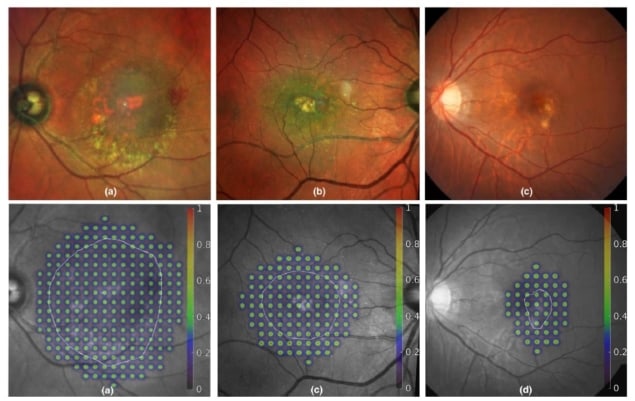
A technique that improves the precision of radiotherapy used to treat wet (neovascular) age-related macular degeneration (AMD) is being developed at Stanford University School of Medicine. Principal investigator Wu Liu and a multinational team of researchers are using polycapillary X-ray optics to deliver focused kilovoltage (kV) radiation. The approach, described in Medical Physics, enables personalized conformal radiotherapy and spares critical structures in the eye, with potential to make AMD treatment more effective, less costly and more convenient for patients.
AMD is the leading cause of blindness in people aged over 50 in developed nations. The International Agency for the Prevention of Blindness estimates that around 196 million people throughout the world currently have AMD, with steady increases projected as the global population ages. The American Academy of Opthalmology estimates that 10–15% of these AMD cases are wet AMD, which is caused by choroidal neovascularization (CNV), the growth of abnormal blood vessels into the macula.
The standard treatment for wet AMD involves repeated intravitreal injections with anti-vascular endothelial growth factor (VEGF) drugs, which helps to control the disease. However, injections are required every 30 to 60 days, are high in cost, and risk causing retinal detachment, injury, infection, bleeding and pain. Radiotherapy could provide an appealing alternative, destroying abnormal vessels and potentially inhibiting associated inflammation and fibrosis not addressed by VEGF inhibitors.

A recent study of radiotherapy for neovascular AMD concluded that the role of stereotactic radiotherapy combined with anti-VEGF is currently uncertain, due primarily to a lack of clinical trial evidence. But Liu and collaborators believe that a combination of radiotherapy with anti-VEGF treatment may be more effective if techniques to deliver stereotactic radiotherapy are improved.
Stereotactic radiotherapy involves targeting high doses of radiation onto a small area, minimizing exposure to surrounding healthy tissues. Two clinical trials (one completed and one with results expected in 2021) have investigated the use of stereotactic radiotherapy to treat wet AMD. The first, the randomized phase II INTREPID trial of 230 individuals dependent on anti-VEGF therapy showed that a single 16 or 24 Gy radiation dose reduced injections by 25%, compared with patients who did not receive radiotherapy.
A follow-up phase III trial, STAR, builds on INTREPID’s findings, which showed that the best response was in patients who had an AMD lesion that was actively leaking at the time of radiotherapy and was smaller than 4 mm. The STAR trial recruited 411 such patients to receive either a single 16 Gy dose or a sham treatment, supplemented by injections as needed over 24 months.
Both of these studies used a collimation-based kV radiotherapy device that delivers fixed 4 mm beams to the centre of macula. This can, however, over- or under-treat CNV lesions of various sizes and shapes.
To enable personalized treatment, Liu and colleagues are developing a system that uses polycapillary X-ray focusing lenses capable of withstanding continuous high-intensity radiation. The polycapillary lens consists of a large number of hollow curved and tapered glass tubes. A converging arrangement of hundreds of thousands of these small channels can produce an X-ray beam with a focus perpendicular to the beam direction of less than 0.2 mm, enabling high-accuracy targeting.

“This ultrasmall beam focal spot enables spatially fractionated grid therapy, which has been shown to preferentially damage abnormal neovascular blood vessels versus normal ones,” write the authors. “The grid dose delivery has the potential to control the CNV while sparing the retina and normal capillaries from the small possibility of radiation-induced retinopathy and capillary dropout associated with conventional radiotherapy.”
The researchers performed Geant4-based Monte Carlo simulations of conformal treatments of three clinical CNV cases, using 60-kVp focused X-ray beams. To estimate possible dosimetric uncertainties to the target and critical organs, they introduced positioning errors that modelled setup errors and patient eye motion during treatment. They also simulated spatially modulated dose delivery to the CNV lesion plus margin to demonstrate the potential of grid therapy.
“The simulated treatments showed highly conformal delivery of dose to the lesion plus 0.75 mm margin with sharp dose fall-offs and controllable spatial modulation patterns,” report the researchers. “The 90–10% isodose penumbra is less than 0.5 mm. With a prescription dose of 16 Gy to the lesions, critical structure doses are well below the tolerance.”
The team also noted that the proposed technique allowed adjustment of the dose distribution based on the distance to the optic disc, to balance the benefits and risks. The average CNV dose varied by no more than 10%.

Retinal imaging goes high resolution
Liu and colleagues suggest that, because of the conformal nature and grid therapy potential of the technique, it may be possible to use focused X-rays alone to treat AMD. The technique could also be used synergistically with anti-VEGF drugs, specifically for newly diagnosed wet AMD patients. Here, patients would receive a single focused X-ray treatment within 14 days of the first anti-VEGF injection, followed by two additional monthly injections and subsequent ones as clinically determined.
“Based on the promising computer simulation results, which show significant dosimetric improvement on wet AMD treatment compared with previously investigated devices, we plan to build a prototype focused kV X-ray platform with a Monte Carlo-based treatment planning system to enable subsequent pre-clinical translational laboratory and clinical research,” Liu tells Physics World. “We hope this technique can be combined synergistically with anti-VEGF drugs to improve the treatment of wet AMD and substantially reduce the frequency of anti-VEGF injections. After successful prototype development and preclinical verifications, we hope to conduct human clinical trials in the next few years.”



